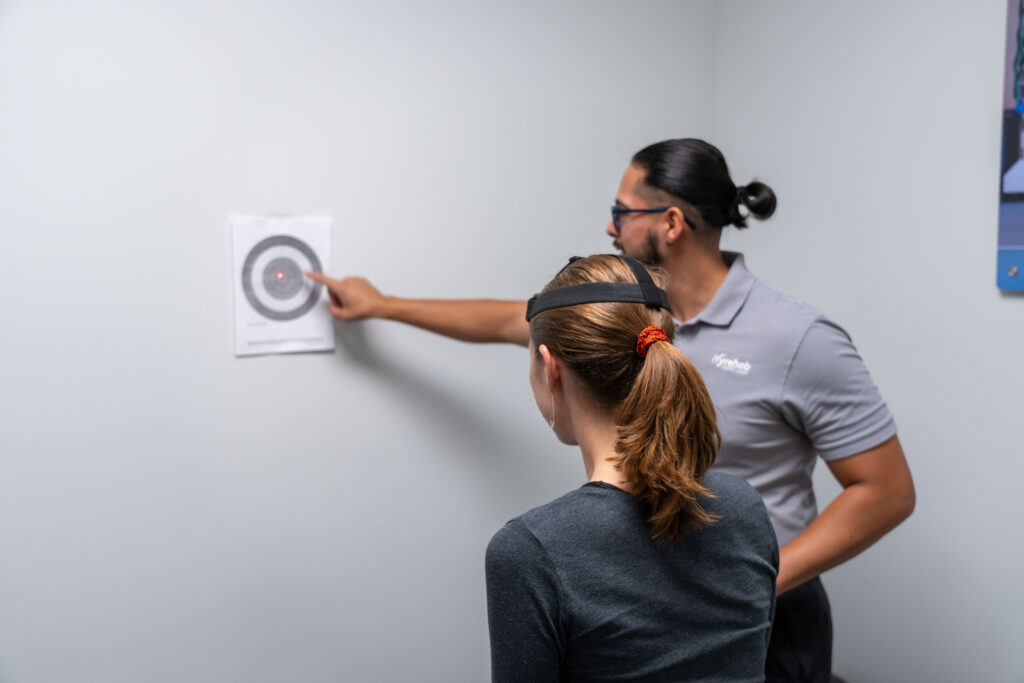
Physical Therapy Treatment for Vertigo
Ivy Rehab Network offers vertigo treatment for patients suffering from benign paroxysmal positional vertigo (BPPV) and balance problems, including issues related to difficulty walking and an unsteady gait.
What is Vertigo Therapy?
Vertigo is a common condition that creates the sensation of having an unbalanced equilibrium. Vertigo is not a specific disease but rather a symptom that results from an issue in the inner ear or brain. Often, individuals experiencing vertigo suffer brief episodes of mild to intense dizziness and sometimes resembling a spinning sensation.
Benign Paroxysmal Positional Vertigo (BPPV) is typically triggered by head movements, such as tilting your head up, down, or side-to-side. While vertigo can be bothersome, it is rarely serious. But vertigo can become dangerous as it increases your risk of falls.


Causes & Risk Factors of Vertigo.
Vertigo can be caused by a problem in the inner ear (peripheral vertigo), or by an issue in the brain or central nervous system (central vertigo). In the case of BPPV, small crystals of calcium carbonate that typically remain in the otolith organs (a structure in the saccule or utricle of the inner ear) enter the semicircular canal located in the inner ear.
These dislodged crystals cause the brain to receive confusing messages about your body’s position. While vertigo can occur at any time, it is most common in individuals who have suffered from a head injury or are using certain medications. In some individuals, alcohol consumption can also trigger vertigo.
Vertigo & BPPV Symptoms:
- Spinning sensation
- Lightheadedness
- Momentary hearing losses
- Motion sickness
- Unsteadiness
- Loss of balance
- Nausea or vomiting
- Sweating
- Abnormal eye movements
- Fear of falling
- Inability to steady one’s visual field
Benefits of Vertigo Physical Therapy
Choosing physical therapy for vertigo offers several advantages:
- Non-invasive and medication-free treatment option
- Personalized exercises targeting your specific vestibular dysfunction
- Improved balance and reduced risk of falls
- Faster symptom relief and better management of dizziness
- Enhanced overall mobility and quality of life
Recovery from Vertigo.
While there are numerous ways to treat and recover from vertigo, physical therapy for vertigo has been one of the most successful forms of treatment. Through the development of a personalized exercise plan, a physical therapist can help you manage your symptoms and create restoration to balance during BPPV treatments such as vestibular rehabilitation, the Brandt-Daroff exercise, and the Semont, Foster and Epley maneuvers. Vertigo therapy typically done with neck and head movements, activities aimed at correcting gaze instability, or in some cases canal repositioning exercises. Since each patient is different, results from dizziness treatment can vary depending on the level of vertigo that the individual is experiencing. However, since physical therapy is so customizable, there is a high likelihood of finding a physical therapy treatment plan that is right for you.

How Vertigo Physical Therapy Works
Our vestibular rehabilitation therapy (VRT) uses targeted exercises to retrain your brain and vestibular system to compensate for inner ear dysfunction. This includes:
- Canalith repositioning procedures (maneuvers): Techniques like the Epley maneuver guide the displaced crystals back to their proper location.
- Gaze stabilization exercises: Help correct visual disturbances and improve eye movement control.
- Balance and gait training: Exercises to improve walking stability and reduce fall risk.
- Habituation exercises: Designed to reduce dizziness through repeated exposure to specific movements that provoke symptoms.
Because every patient’s vertigo symptoms and severity vary, your therapist will tailor the treatment plan to your individual needs, ensuring the best chance for recovery and symptom management.

Start living your best life.
Begin your journey close to home.
FAQs
Can physical therapy cure vertigo completely?
Physical therapy is highly effective, especially for vertigo caused by vestibular disorders such as BPPV. Many patients experience significant relief or even complete resolution of vertigo symptoms following therapy. However, the success of treatment depends on the specific cause of vertigo. For example, BPPV often responds very well to canalith repositioning maneuvers, while vertigo related to neurological conditions might require longer-term management. Chronic or complex cases might require ongoing therapy or additional medical evaluation. Overall, physical therapy aims to reduce symptoms, improve balance, and enhance quality of life.
How long does vertigo therapy take?
The duration of vertigo therapy varies depending on the severity of symptoms, the underlying cause, and how consistently the patient follows their treatment plan. Many patients begin to notice improvements within a few weeks of starting therapy, especially with conditions like BPPV. Some individuals may require several weeks to a few months of regular sessions and at-home exercises to achieve significant relief. Your physical therapist will continuously assess your progress and may adjust your therapy plan to help you recover as efficiently as possible.
What are some common exercises used to treat vertigo?
Several targeted exercises and maneuvers are used in physical therapy to treat vertigo, especially vestibular-related dizziness. These can include, but aren’t limited to:
- Epley Maneuver: A series of guided head and body movements designed to reposition dislodged calcium crystals in the inner ear back to their correct location.
- Semont Maneuver: A quick, side-to-side movement technique that also helps move crystals out of the semicircular canals.
- Brandt-Daroff Exercises: Repetitive movements performed at home that habituate the brain to dizziness-provoking stimuli help reduce symptoms over time.
- Gaze Stabilization Exercises: These involve focusing on a stationary or moving target while moving the head to improve visual stability and reduce dizziness.
- Balance and Gait Training: Exercises designed to improve coordination, posture, and walking stability to prevent falls.
- Habituation Exercises: Controlled exposure to movements or positions that trigger dizziness to help the nervous system adapt and reduce symptoms.

